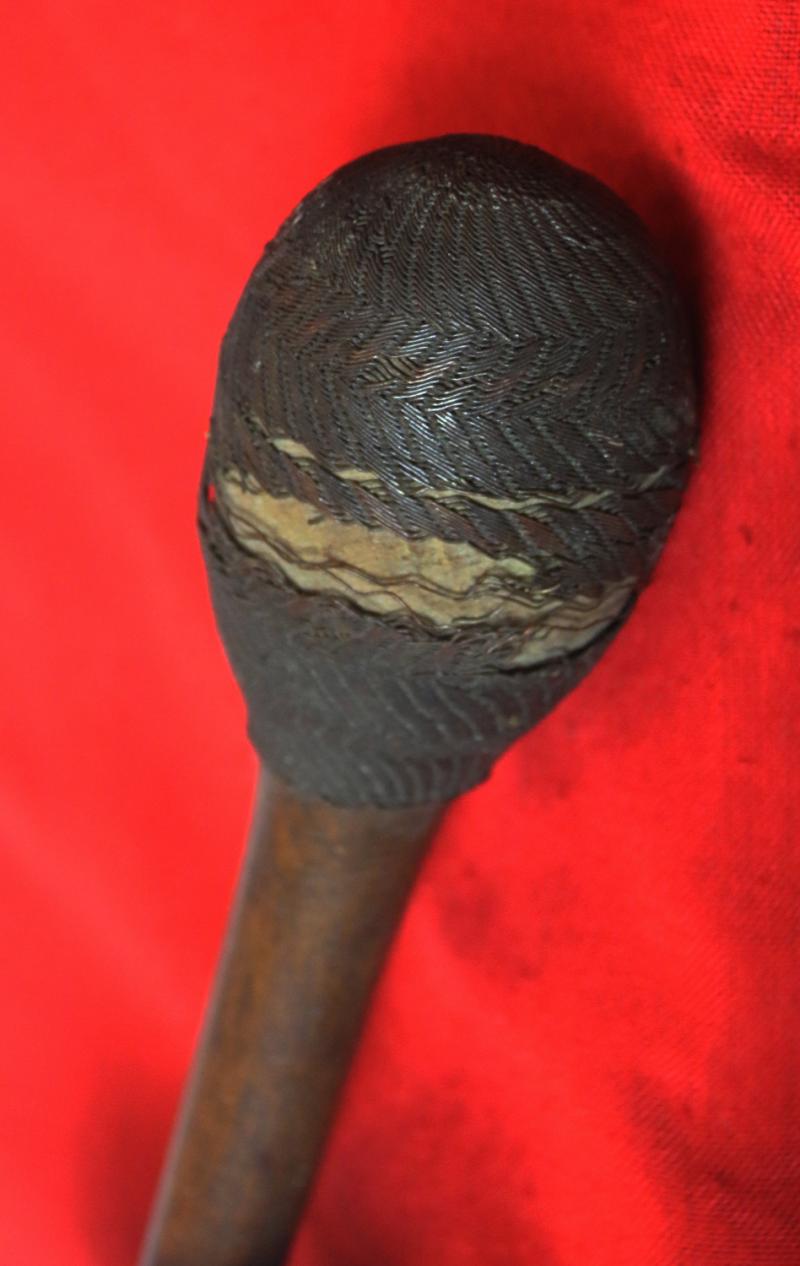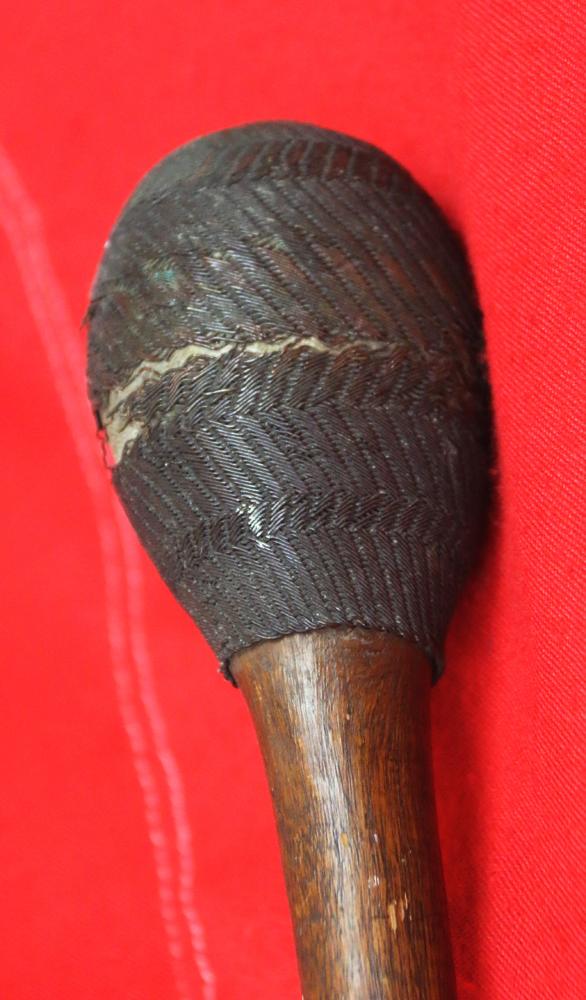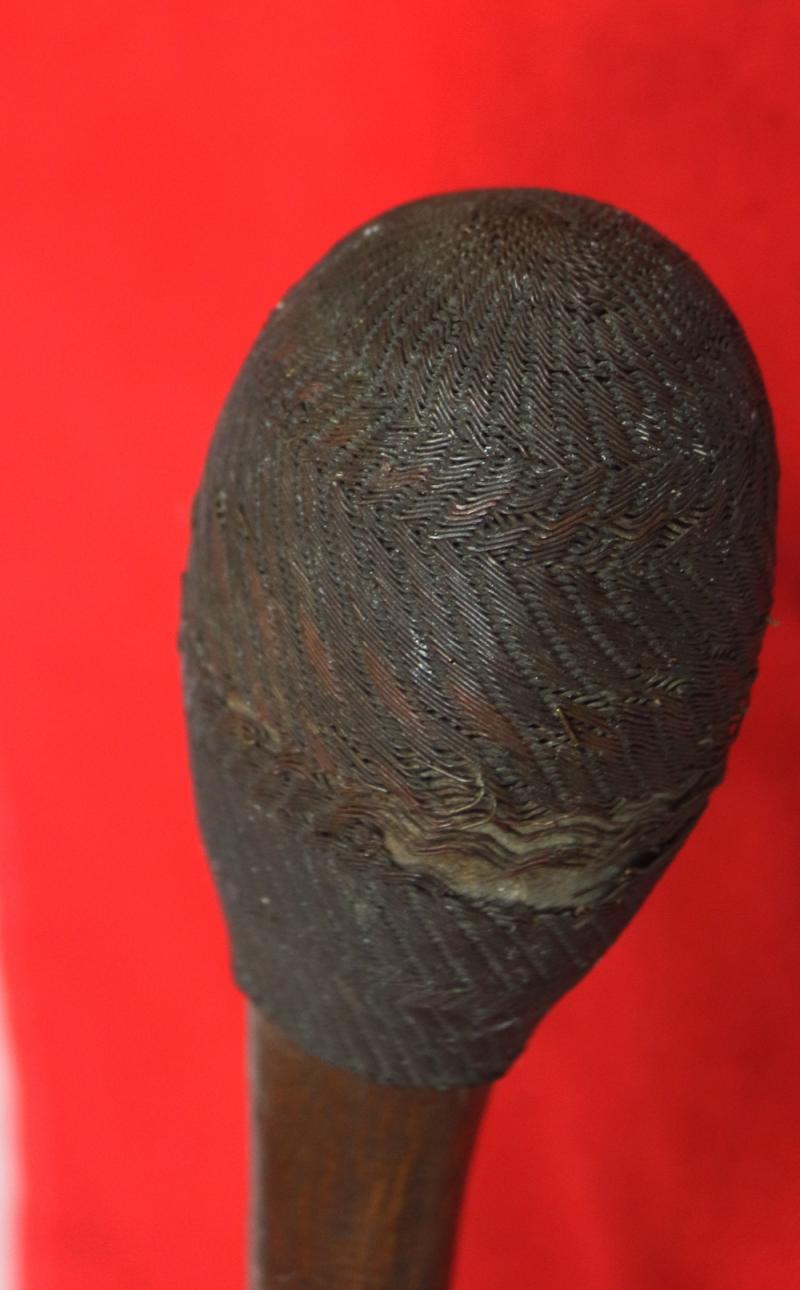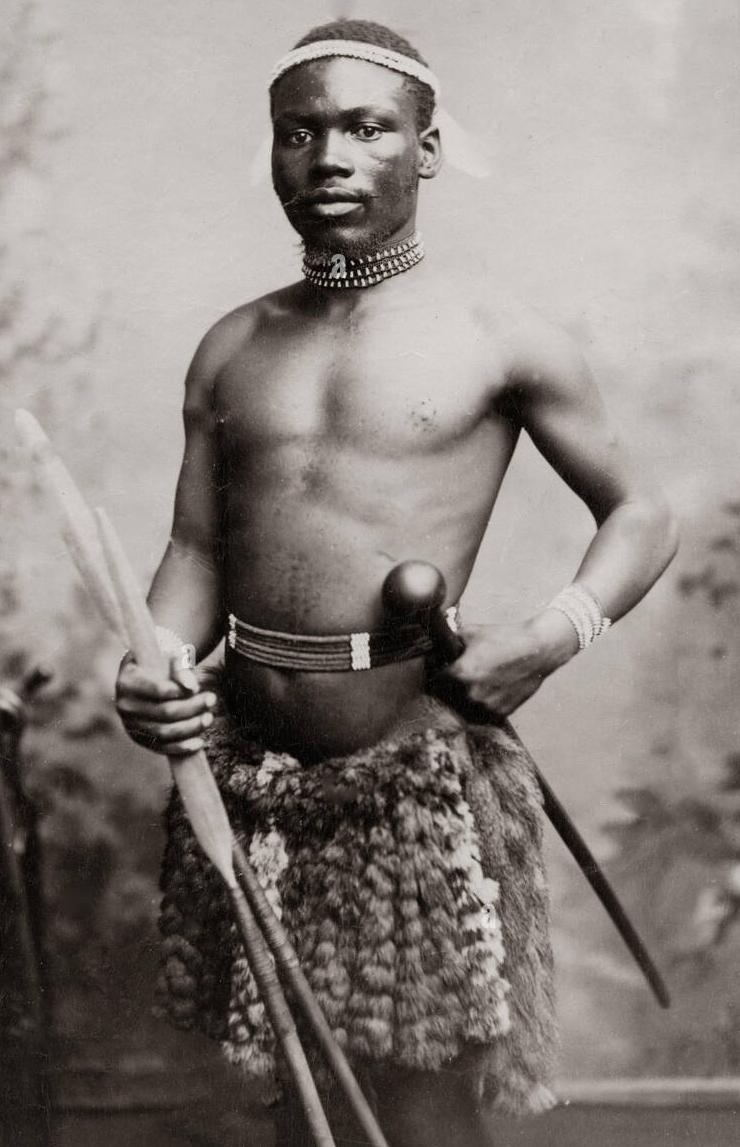A Most Unusual, Original Zulu War of 1879 Souvenir, Of A High Ranked Zulu Impi Warrior's Knopkerrie War Club, With Telegraph Wire Geometric Wirework Knob
The Zulus would frequently cut down the British military telegraph wires, strip them, and create wirework decorative patterns on their spear and knopkerrie hafts. That is a desireable feature on the spears and clubs, when found, but we can't recall ever seeing the entire clubhead bound in the wirework before such as this one.
The wirework has had some unravelling but most is still beautifully intact.
During the period of this knopkerries use, two of most famous pair of engagements in the British army's history, during the last quarter of the 19th century, happened over two consecutive days. Curiously, it is fair to say that these two engagements, by the 24th Foot, against the mighty Zulu Impi, are iconic examples of how successful or unsuccessful leadership can result, in either the very best conclusion, or the very worst. And amazingly, within only one day of each other. The 1879 Zulu War, for the 24th Foot, will, for many, only mean two significant events, Isandlhwana and Rorke's Drift. This is the brief story of the 24th Foot in South Africa; In 1875 the 1st Battalion arrived in Southern Africa and subsequently saw service, along with the 2nd Battalion, in the 9th Xhosa War in 1878. In 1879 both battalions took part in the Zulu War, begun after a British invasion of Zululand, ruled by Cetshwayo. The 24th Foot took part in the crossing of the Buffalo River on 11 January, entering Zululand. The first engagement (and the most disastrous for the British) came at Isandhlwana. The British had pitched camp at Isandhlwana and not established any fortifications due to the sheer size of the force, the hard ground and a shortage of entrenching tools. The 24th Foot provided most of the British force and when the overall commander, Lord Chelmsford, split his forces on 22 January to search for the Zulus, the 1st Battalion (5 companies) and a company of the 2nd Battalion were left behind to guard the camp, under the command of Lieutenant-Colonel Henry Pulleine (CO of the 1/24th Foot).
The Zulus, 22,000 strong, attacked the camp and their sheer numbers overwhelmed the British. As the officers paced their men far too far apart to face the coming onslaught. During the battle Lieutenant-Colonel Pulleine ordered Lieutenants Coghill and Melvill to save the Queen's Colour—the Regimental Colour was located at Helpmakaar with G Company. The two Lieutenants attempted to escape by crossing the Buffalo River where the Colour fell and was lost downstream, later being recovered. Both officers were killed. At this time the Victoria Cross (VC) was not awarded posthumously. This changed in the early 1900s when both Lieutenants were awarded posthumous Victoria Crosses for their bravery. The 2nd Battalion lost both its Colours at Isandhlwana though parts of the Colours—the crown, the pike and a colour case—were retrieved and trooped when the battalion was presented with new Colours in 1880.
The 24th had performed with distinction during the battle. The last survivors made their way to the foot of a mountain where they fought until they expended all their ammunition and were killed. The 24th Foot suffered 540 dead, including the 1st Battalion's commanding officer.
After the battle, some 4,000 to 5,000 Zulus headed for Rorke's Drift, a small missionary post garrisoned by a company of the 2/24th Foot, native levies and others under the command of Lieutenant Chard, Royal Engineers, the most senior officer of the 24th present being Lieutenant Gonville Bromhead. Two Boer cavalry officers, Lieutenants Adendorff and Vane, arrived to inform the garrison of the defeat at Isandhlwana. The Acting Assistant Commissary James Langley Dalton persuaded Bromhead and Chard to stay and the small garrison frantically prepared rudimentary fortifications.
The Zulus first attacked at 4:30 pm. Throughout the day the garrison was attacked from all sides, including rifle fire from the heights above the garrison, and bitter hand-to-hand fighting often ensued. At one point the Zulus entered the hospital, which was stoutly defended by the wounded inside until it was set alight and eventually burnt down. The battle raged on into the early hours of 23 January but by dawn the Zulu Army had withdrawn. Lord Chelmsford and a column of British troops arrived soon afterwards. The garrison had suffered 15 killed during the battle (two died later) and 11 defenders were awarded the Victoria Cross for their distinguished defense of the post, 7 going to soldiers of the 24th Foot.
Each Impi was made up of several ibutho, each approximately 1,000 warriors strong plus the young boys acting as servants and scouts for the army. Each had its own shield colours, and other emblems such as head dresses. The amount of black and white on a shield allowed the Zulu commanders to know exactly what regiment was where on the battlefield, much like the colours of the regiments did for the European armies. Shaka needed a fast mobile army, as early in his campaigns he was outnumbered and needed to manoeuvre quickly, so to ensure this the warriors were made to run bare foot so the loss of a sandal wouldn’t disable them and their feet were hardened, by frequent runs over the hot stony ground and by stamping thorns into the ground so that scar tissue would form.
In battle the troops were lightly equipped apart from a shield - any armour would have been impractical and useless anyway when facing European armies with guns. The elaborate dress seen in many films is a misconception and mainly ceremonial. Standard weapons were a short broad bladed stabbing spear and a heavy club, Shaka introduced the short stabbing spear and warriors did not carry spares so did not throw them in battle. Some regiments re-introduced throwing spears when facing the European and Boer armies but by this time they were also using looted firearms and primitive muskets traded to them by Arab traders. Although lacking the fire power of the modern armies European armies they later faced the Zulus were well disciplined and brave and once they closed with the enemy their greater training in close combat and the advantage of having a shield made them lethal. They were also know for the ritual of “washing of the spears” - a tradition of cutting open fallen enemies’ bellies so that their ghost/ spirit would be free and not haunt the person who killed him. This was seized upon by the media to help portray the Zulus as blood thirsty savages. Discipline was harsh but not exceptionally so if compared to contemporary European armies, cowards were shamed and normally executed and the brave honoured, basic battlefield medicine was practised but the Zulus had surprisingly good causality recovery rates.
Code: 24957
375.00 GBP






